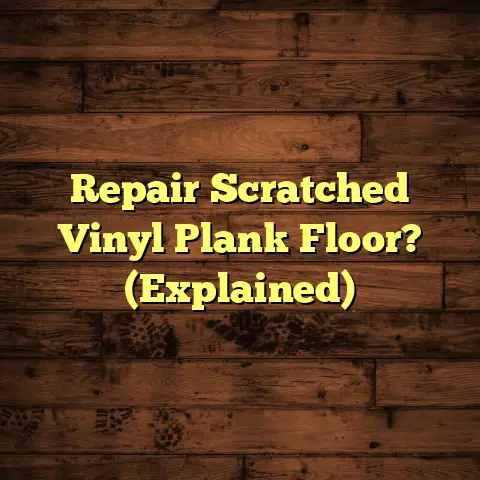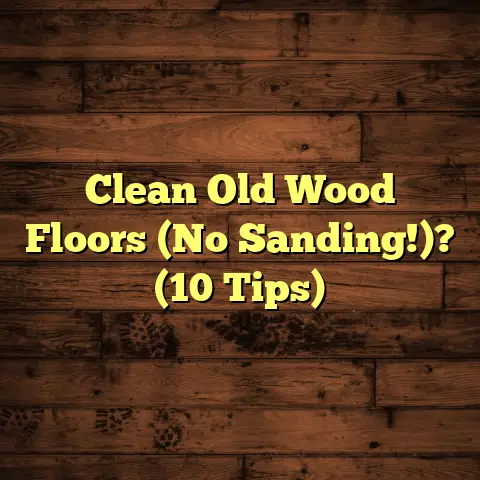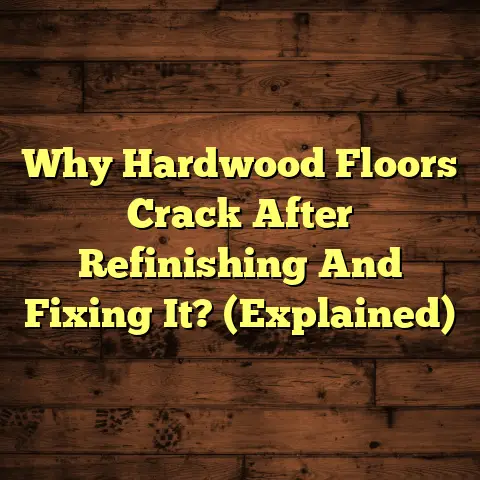Hardwood Over Hardwood? (2 Subfloor Blunders!)
In a world brimming with flooring options, why does the choice of installing hardwood over hardwood often lead to frustration rather than satisfaction?
It’s a paradox, right? You’d think adding more of a good thing would be great, but flooring, like life, is rarely that simple.
I’m a flooring contractor, and I’ve seen it all. Beautiful hardwood dreams turn into costly nightmares because of a few easily avoidable mistakes.
Let’s dive into why hardwood over hardwood can be a tricky game and, more importantly, how to avoid the common pitfalls.
1. Understanding the Allure of
Hardwood Over Hardwood
1.1 The Aesthetic Appeal
Let’s be honest, who doesn’t love the look of hardwood? It’s timeless, elegant, and adds a touch of class to any room.
Homeowners are often drawn to the idea of enhancing their space with new hardwood without the messy, disruptive process of tearing out the old floor.
It sounds good in theory, doesn’t it? Just lay the new floor right on top! But hold on, we’re not quite there yet.
1.2 The Economic Consideration
Money talks. And the thought of saving a few bucks is always tempting. Removing an existing hardwood floor is labor- intensive, which means higher costs.
Some homeowners see installing new hardwood over old as a way to sidestep these expenses. They think, “Why pay someone to rip it up when I can just cover it?”
I get the logic, but trust me, cutting corners here can cost you way more in the long run.
Think about this: a typical hardwood removal can cost anywhere from $2 to $6 per square foot. (Source: HomeAdvisor).
That can add up quickly! However, repairing a poorly installed floor due to subfloor issues can easily exceed that.
1.3 The Environmental Perspective
Okay, I’ll admit it, there’s a green angle here. Reusing existing materials is more sustainable than sending them to a landfill.
Demolition and disposal generate a lot of waste. So, in theory, keeping the old hardwood and building on top of it is an eco-friendly choice.
But, and this is a big but, if that old floor is causing problems, you’re just burying them under a beautiful new layer.
It’s like putting a fresh coat of paint on a rotting fence – it might look good for a minute, but the underlying issues are still there.
2. The First Subfloor Blunder –
Inadequate Preparation
This is where things get real. You can’t just slap new hardwood on top of old and expect a perfect result.
The key to a successful installation is all about the subfloor. And that means assessing the existing hardwood.
2.1 The Importance of Subfloor
Assessment
Before you even think about buying new wood, you need to become a detective. Grab a level, a moisture meter, and get ready to inspect that old floor.
Look for warping, cupping (where the edges of the boards are higher than the center), or any signs of water damage.
Check for loose boards and make sure the existing floor is securely fastened to the subfloor beneath.
Stability is crucial. If the old floor is moving, your new floor will move with it. And that’s a recipe for disaster.
I once worked on a project where the homeowner insisted on installing new hardwood over an old, warped floor.
I warned them it was a bad idea, but they were determined to save money. Six months later, they called me back with a floor that was squeaking, buckling, and looked terrible. They ended up paying twice as much to fix the problem.
2.2 The Role of Moisture
Moisture is the enemy of hardwood. Always!
If the existing floor has high moisture content, installing another layer on top will only trap that moisture, leading to mold, mildew, and rot.
You need to use a moisture meter to check the moisture levels of both the existing hardwood and the subfloor below.
Ideally, the moisture content of the hardwood should be between 6% and 9%. (Source: National Wood Flooring Association).
Anything higher than that, and you’re asking for trouble.
I’ve seen floors ruined because homeowners didn’t bother to check moisture levels. The new hardwood started to buckle and warp within weeks, and the smell of mold was overwhelming.
Don’t skip this step! It’s worth the investment in a good moisture meter to avoid a costly mistake.
2.3 Failure to Level
Imagine building a house on a shaky foundation. That’s essentially what you’re doing when you install hardwood over an uneven subfloor.
Even small dips and bumps can cause problems. Uneven surfaces can lead to squeaking, gaps, and uneven wear on your new floor.
You need to use a self-leveling compound to create a smooth, flat surface before installing the new hardwood.
It’s a bit of extra work, but it’s essential for a professional-looking and long-lasting result.
I remember one job where the homeowner tried to save money by skipping the self- leveling compound. They thought they could just “shim” the low spots.
The floor looked okay at first, but within a few months, the shims started to compress, creating dips and squeaks. They ended up ripping out the entire floor and starting over.
3. The Second Subfloor Blunder –
Ignoring Proper Installation Techniques
Okay, let’s say you’ve done your homework. You’ve assessed the subfloor, checked for moisture, and leveled the surface.
Now comes the crucial part: the installation. This is where attention to detail is paramount.
3.1 The Importance of Installation Method
There are several ways to install hardwood flooring: nail-down, glue-down, and floating. Each method has its own specific requirements and is not equal.
When installing over existing hardwood, the glue-down or floating methods are generally preferred.
Nailing down can be problematic because you risk damaging the existing floor and potentially hitting pipes or wires.
Glue-down provides a solid, stable connection, but it requires a perfectly smooth and clean surface.
Floating floors are easier to install and can be more forgiving of minor imperfections, but they can also feel less solid underfoot.
Choosing the right method depends on the specific conditions of your subfloor and the type of hardwood you’re installing.
3.2 The Consequences of Poor Installation
I’ve seen it all: improper spacing, lack of expansion gaps, and failure to follow manufacturer guidelines. These mistakes can lead to serious problems down the road.
Improper spacing can cause the floor to buckle or crack as the wood expands and contracts with changes in humidity.
Lack of expansion gaps can create pressure points that lead to warping and cupping.
And ignoring manufacturer guidelines is just plain foolish. They know their product best, and their instructions are there for a reason.
I once had a client who insisted on using a cheaper adhesive than the one recommended by the flooring manufacturer.
Within a year, the floor started to separate from the subfloor, creating large gaps and making the floor unsafe to walk on.
They ended up spending thousands of dollars to repair the damage and reinstall the floor correctly.
3.3 The Role of Underlayment
Underlayment is a thin layer of material that is installed between the subfloor and the hardwood flooring.
It provides a number of benefits, including sound insulation, moisture protection, and thermal efficiency.
When installing hardwood over hardwood, underlayment is especially important. It can help to cushion the floor, reduce noise transmission, and prevent moisture from wicking up from the subfloor.
There are many different types of underlayment available, each with its own unique properties.
Some are designed to reduce sound transmission, while others are better at blocking moisture.
The best type of underlayment for your project will depend on your specific needs and the conditions of your subfloor.
I always recommend using a high-quality underlayment that is specifically designed for hardwood flooring. It’s a small investment that can make a big difference in the long run.
4. Case Studies of Successful and
Failed Installations
Let’s look at some real-world examples to illustrate the dos and don’ts of installing hardwood over hardwood.
4.1 Success Stories
I worked with a homeowner who wanted to install new hardwood in their living room. The existing hardwood was in decent shape, but it was a bit worn and outdated.
We started by thoroughly assessing the subfloor and checking for moisture. We found a few minor imperfections, which we corrected with self-leveling compound.
We then installed a high-quality underlayment and used a glue-down method to install the new hardwood.
We followed the manufacturer’s instructions carefully and paid close attention to spacing and expansion gaps.
The result was a beautiful, durable floor that the homeowners loved. They were especially pleased with the sound insulation provided by the underlayment.
4.2 Cautionary Tales
On the other hand, I had a client who tried to cut corners by installing new hardwood over an old, uneven floor.
They didn’t bother to check for moisture or use a self-leveling compound. They simply nailed the new hardwood directly to the old floor.
Within a few months, the floor started to squeak and buckle. The uneven surface caused the new hardwood to wear unevenly, and the lack of moisture protection led to mold and mildew growth.
The homeowners ended up having to rip out the entire floor and start over. They spent twice as much money as they would have if they had done it right the first time.
5. Conclusion – The Path Forward
So, we’ve come full circle. We started with the paradox of choice and ended with a clear understanding of the potential pitfalls of installing hardwood over hardwood.
While the idea of adding more hardwood may seem appealing, it’s crucial to approach the project with caution and knowledge.
Remember the two subfloor blunders: inadequate preparation and ignoring proper installation techniques.
Avoid these mistakes, and you’ll be well on your way to a beautiful, long-lasting hardwood floor.
Ultimately, the best path forward is to seek professional advice. A qualified flooring contractor can assess your subfloor, recommend the best installation method, and ensure that the job is done right.
Don’t let the allure of a quick and easy fix lead you down the wrong path. Invest in quality preparation and installation, and you’ll enjoy your hardwood floor for years to come.
So, what are your thoughts? Have you ever considered installing hardwood over hardwood? What concerns do you have? Let’s chat in the comments below!





